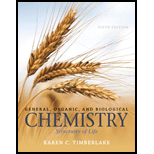
Concept explainers
Interpretation:
Each of the given chemical compounds should be identified as a part of the citric acid cycle, electron transport chain or both.
Concept introduction:
► Citric acid cycle includes various reactions which occur in living cells during aerobic respiration. In this cycle, acetyl-CoA is oxidized for releasing carbon dioxide and energy in the form of ATP.
► Electron transport chain is the last step of aerobic respiration and includes a sequence of
To identify: Each of the given compounds as a part of citric acid cycle, electron transport chain or both.
Answer to Problem 23.51UTC
Solution:
(a) Citric acid cycle.
(b) Electron transport chain.
(c) Both citric acid cycle and electron transport chain.
(d) Electron transport chain.
(e) Citric acid cycle.
Explanation of Solution
(a) Succinate is a chemical species formed from Succinyl CoA during citric acid cycle. It produces fumarate after its reaction with succinic dehydrogenase.
For this reason, succinate is a part of citric acid cycle.
(b) is a chemical species that produces complex III along with cytochrome c reductase (-cytochrome creductase complex) and helps in transfer of electrons.
For this reason, is a part of electron transport chain.
(c) FAD (Flavin adenine dinucleotide) is a cofactor of redox reactions. It helps in controlled redox reactions in both citric acid cycle and electron transport chain and releases energy as ATP.
For this reason, FADis a part of both citric acid cycle and electron transport chain.
(d) Cyt c (Fe2+) is a type of hemeprotein found in mitochondrial membrane. It participates in electron transport chain and helps in transfer of electrons.
For this reason, cyt c (Fe2+) is a part of electron transport chain.
(e) Citrate is a chemical species formed from acetyl-CoA during citric acid cycle. It produces cis-aconitate after its reaction with aconitase.
For this reason, α-ketoglutarate is a part of citric acid cycle.
Each of the given chemical compounds is identified as a part of citric acid cycle, electron transport chain or both.
Want to see more full solutions like this?
Chapter 23 Solutions
General, Organic, and Biological Chemistry: Structures of Life (5th Edition)
- give example for the following(by equation) a. Converting a water insoluble compound to a soluble one. b. Diazotization reaction form diazonium salt c. coupling reaction of a diazonium salt d. indacator properties of MO e. Diazotization ( diazonium salt of bromobenzene)arrow_forward2-Propanone and ethyllithium are mixed and subsequently acid hydrolyzed. Draw and name the structures of the products.arrow_forward(Methanesulfinyl)methane is reacted with NaH, and then with acetophenone. Draw and name the structures of the products.arrow_forward
- 3-Oxo-butanenitrile and (E)-2-butenal are mixed with sodium ethoxide in ethanol. Draw and name the structures of the products.arrow_forwardWhat is the reason of the following(use equations if possible) a.) In MO preperation through diazotization: Addition of sodium nitrite in acidfied solution in order to form diazonium salt b.) in MO experiment: addition of sodium hydroxide solution in the last step to isolate the product MO. What is the color of MO at low pH c.) In MO experiment: addition of sodium hydroxide solution in the last step to isolate the product MO. What is the color of MO at pH 4.5 d.) Avoiding not cooling down the reaction mixture when preparing the diazonium salt e.) Cbvcarrow_forwardA 0.552-g sample of an unknown acid was dissolved in water to a total volume of 20.0 mL. This sample was titrated with 0.1103 M KOH. The equivalence point occurred at 29.42 mL base added. The pH of the solution at 10.0 mL base added was 3.72. Determine the molar mass of the acid. Determine the Ka of the acid.arrow_forward
- As the lead product manager at OrganometALEKS Industries, you are trying to decide if the following reaction will its major product: 2,0° with a new C-C bond as If this reaction will work, draw the major organic product or products you would expect in the drawing aree below. If there's more than one major product, you can draw them in any arrangement you like. Be sure you use wedge and desh bonds if necessary, for example to distinguish between major products with different stereochemistry. If the major products of this reaction won't have a new C-C bond, just check the box under the drawing area and leave it blank.arrow_forwardwrite the mechanism of the nucleophilic acyl substitution reaction, please give an examplearrow_forwardThe compound in the figure is reacted with 10 n-butyllihium, 2° propanone, and 3º H2O. Draw and name the products obtained. SiMe3arrow_forward
- Caffeine (C8H10N4O2, pictured below) is a weak base. The pKb of caffeine is 10.4. What is the pH of a 0.0155 M solution of caffeine?arrow_forward2-Cyclopentyl-2-methyl-1,3-dioxolane is reacted with H₂SO₄. Draw and name the structures of the products.arrow_forwardIndicate the products of the reaction of 1-cyclohexyl-2,2-dimethylpropan-1-one with CH3CO3H (). Draw the structures of the compounds.arrow_forward
 ChemistryChemistryISBN:9781305957404Author:Steven S. Zumdahl, Susan A. Zumdahl, Donald J. DeCostePublisher:Cengage Learning
ChemistryChemistryISBN:9781305957404Author:Steven S. Zumdahl, Susan A. Zumdahl, Donald J. DeCostePublisher:Cengage Learning ChemistryChemistryISBN:9781259911156Author:Raymond Chang Dr., Jason Overby ProfessorPublisher:McGraw-Hill Education
ChemistryChemistryISBN:9781259911156Author:Raymond Chang Dr., Jason Overby ProfessorPublisher:McGraw-Hill Education Principles of Instrumental AnalysisChemistryISBN:9781305577213Author:Douglas A. Skoog, F. James Holler, Stanley R. CrouchPublisher:Cengage Learning
Principles of Instrumental AnalysisChemistryISBN:9781305577213Author:Douglas A. Skoog, F. James Holler, Stanley R. CrouchPublisher:Cengage Learning Organic ChemistryChemistryISBN:9780078021558Author:Janice Gorzynski Smith Dr.Publisher:McGraw-Hill Education
Organic ChemistryChemistryISBN:9780078021558Author:Janice Gorzynski Smith Dr.Publisher:McGraw-Hill Education Chemistry: Principles and ReactionsChemistryISBN:9781305079373Author:William L. Masterton, Cecile N. HurleyPublisher:Cengage Learning
Chemistry: Principles and ReactionsChemistryISBN:9781305079373Author:William L. Masterton, Cecile N. HurleyPublisher:Cengage Learning Elementary Principles of Chemical Processes, Bind...ChemistryISBN:9781118431221Author:Richard M. Felder, Ronald W. Rousseau, Lisa G. BullardPublisher:WILEY
Elementary Principles of Chemical Processes, Bind...ChemistryISBN:9781118431221Author:Richard M. Felder, Ronald W. Rousseau, Lisa G. BullardPublisher:WILEY





